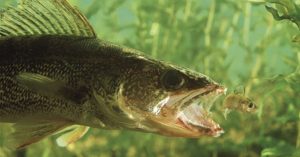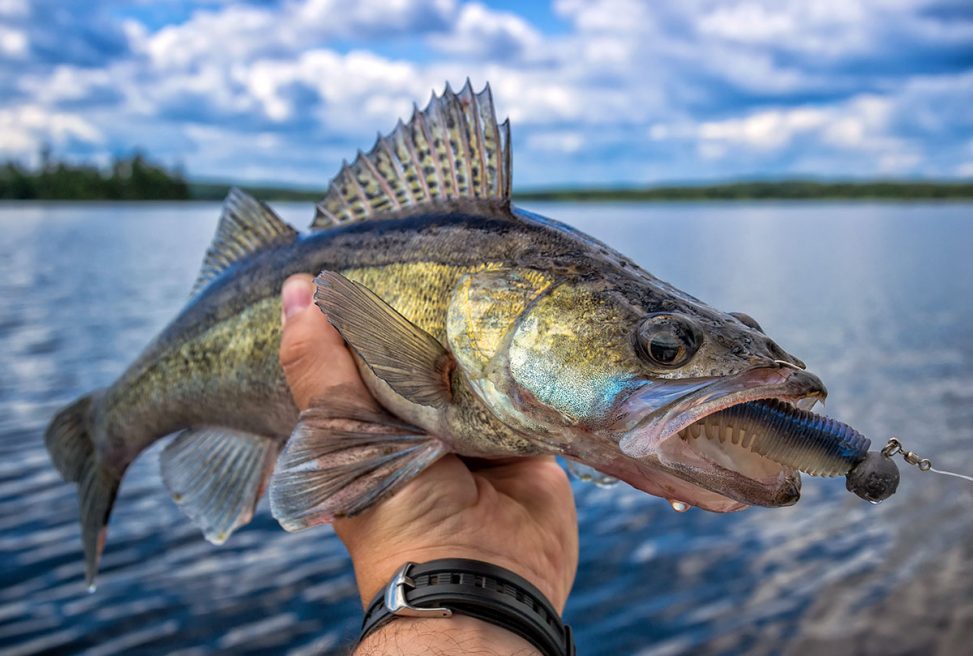So why are our fish getting smaller? A recent study by biologists from the University of Minnesota and Minnesota Department of Natural Resources found that freshwater fish may be significantly smaller after their first year as a result of the presence of exotic Zebra Mussels (Dreissena polymorpha) and Spiny Water Fleas (Bythotrephes cederstroemi).
The study, which took place over a 35-year timespan, compared the growth of Walleye (Sander vitreus) within nine lakes in Minnesota. Walleye are a popular game fish and are a top predator in many of North America’s lakes and rivers. Unfortunately, the study found that Walleye in lakes with nonnative Zebra Mussels and Spiny Water Fleas are up to 14% smaller than their counterparts found in lakes without the invaders.

pictured above is a Walleye chasing after a bate fish. Walleye are a top freshwater predator in North America and can grow up to 3ft in length and weigh as much as 20lb.
The Zebra Mussel and Spiny Water flea are originally from northern Europe and Asia, and were unintentionally introduced into the United State where they rapidly colonized North America’s rivers, lakes, and waterways. Both species are currently listed as an aquatic invasive species (AIS) in the United States due to their ability to cause significant ecological and economic damage.

As its name suggests the Spiny Water flea has spikes that make it inedible to most fish species. The Water Flea is a species of predatory Zooplankton that in North America feeds exclusively on native zooplankton species. (picture credit of Minnesota Department of Natural Resources)
The study suggests that Walleye growth is most stunted between the ages of zero and one. The researchers believe young fish are particularly vulnerable due to competition for prey species from the Zebra Mussel and Water Flea. Newly hatched Walleye are small, and rely on tiny organisms called zooplankton for their first year. Unfortunately, Zebra Mussels and Water Fleas feed almost exclusively on these tiny organisms, which are causing critical zooplankton populations to crash.
Larger Walleye as well as more opportunistic fish species such as Yellow Perch (Perca flavescens), have been able to make an adjustment and feed on alternative food sources. Younger Walleye however, feed almost exclusively on zooplankton for their first year and aren’t big enough to find alternative prey. The result, according to the study is smaller Walleye.
According to Gretchen Hansen, an assistant professor from the Department of Fisheries at the University of Minnesota “growth of fishes is critical to survival to later life stages”. Dr. Hansen goes on to state “Larger fishes are less likely to succumb to size-related predation and have access to a more diverse prey base”. Essentially, what Dr. Hansen is saying is the bigger you are the more prey you can swallow and the less predators that can swallow you.
Overall, smaller Walleye also mean less Walleye, and the implications are far broader than disappointing wranglers in search of a fish worthy of a trophy. According to the researchers, the decline of a top predator such as the Walleye, could set into motion a “trophic cascade” wherein the consequences reverberate throughout an ecosystem. The researchers warn that if populations of Zebra Mussels and Spiny Water Fleas aren’t controlled, trophic cascades could unfold throughout North America’s aquatic environments and many other species could face declines.

Zebra Mussels are notorious for forming dense colonies where they feed on zooplankton within the water column. Above a colony of Zebra Mussels were observed covering the seabed on Lake Michigan. (Photo credit of Mel Clark photography)
Going forward, the researchers plan to conduct research examining the effects of AIS on early growth stages in various fish species across a broader coalition of lakes. The researchers hope their findings can be used to help elucidate the mechanisms of AIS and their broader impacts on native fish species.
References:
Hansen, J. A. G., Ahrenstorff, D. T., Bethke, J. B., Dumke, D. J., Hirsch, J., Kovalenko, E. K., LeDuc, F. J., Maki, P. R., Rantala, M. H., and Tyler, W. 2020. Walleye growth declines following zebra mussel and Bythotrephes invasion. Bio Invasions: 22, pp. 1481-1495.

Alex
"This title was very eye catching! That is so interesting that such a ..."
Alex
"This is really interesting! The fact that crops and plants are damaged is ..."
Alex
"Well done, this article is great and the information is very captivating! Ethics ..."
Alex
"I was intrigued throughout the whole article! This is such an interesting topic, ..."
Alex
"This is such an interesting article, and very relevant!! Great job at explaining ..."
Grandpa
"Honey You Did a good job I will forward to my eye doctor "
murphymv
"This article is fascinating because it delves into the details of the research ..."
murphymv
"I agree, adding the photo helped solidify the main finding. "
murphymv
"This is a fascinating finding. I hope this innovative approach to improving transplants ..."
Sherzilla
"This is a great article! I would really love to hear how exactly ..."
Sherzilla
"It's disappointment that these treatments were not very effective but hopefully other researchers ..."
Sherzilla
"I agree with your idea that we need to shift our focus to ..."
Sherzilla
"It's amazing to see how such an everyday household product such as ..."
Lauren Kageler
"I will be interested to see what the data looks like from the ..."
Lauren Kageler
"A very interesting article that emphasizes one of the many benefits that the ..."
maricha
"Great post! I had known about the plight of Little Browns, but I ..."
Sherzilla
"I assumed cancer patients were more at risk to the virus but I ..."
Sherzilla
"Great article! It sheds light on a topic that everyone is curious about. ..."
maricha
"This article is full of really important and relevant information! I really liked ..."
maricha
"Definitely a very newsworthy article! Nice job explaining the structure of the virus ..."
maricha
"It's interesting to think that humans aren't only species dealing with the global ..."
murphymv
"This is very interesting and well explained. I am not too familiar with ..."
Lauren Kageler
"Great article! This post is sure to be a useful resource for any ..."
Lauren Kageler
"Definitely seems like an odd pairing at first, but any step forward in ..."
murphymv
"What an interesting article! As you say, height and dementia seem unrelated at ..."
murphymv
"Great article! I learned several new methods of wildlife tracking. This seems like ..."
murphymv
"Very interesting topic! You explained cascade testing and its importance very well. I ..."
Alex
"This article is really interesting! What got me hooked right away was the ..."
Sabrina
"I found this article super interesting! It’s crazy how everyday products can cause ..."
Erin Heeschen
"I love the layout of this article; it's very eyecatching! The advancements of prosthetics ..."
murphymv
"Awesome article! I like the personality in the writing. Flash Graphene not only ..."
murphymv
"Very interesting work! I don't know a whole lot about genetics, but this ..."
Cami Meckley
"I think the idea of using virtual reality technology to better help prepare ..."
Erin Heeschen
"I wonder if there's a connection between tourist season and wildfires in the ..."
Ralph berezan
"Not bad Good work "
Michelle
"This sounds like it would be a great tool for medical students! ..."